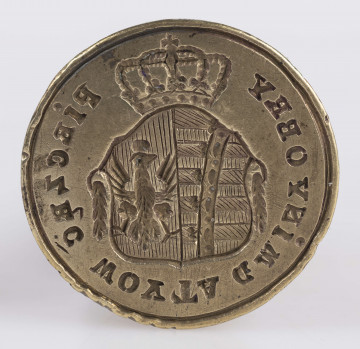
Casimir IV Jagiellon's crown half-grosz
National Museum in Lublin
Part of the collection: Money on Polish territory in the Middle Ages
Denars were minted in Poland since the beginning of minting in our lands, namely since the times of Bolesław Chrobry. During the first centuries of the existence of the Polish state, they were the basis of the monetary system. Hence that period is called the denarius system. It was not until the times of Casimir the Great that they were replaced by the penny system, in which denars became a fine coin. During the reign of the last Piast king, only obols had a lower value. During the reign of the first Jagiellons, denars became the lowest denomination coin.
Denars of Władysław of Varna played a unique role in the Polish monetary system as they were the only coins minted during the reign of this ruler. They were produced on a considerable scale. It stemmed from the economic needs of the ruler of Poland and Hungary, involved in a costly war with Turkey. The production of coins gave him minting profit, which was increased by lowering the silver content. Additionally, various procedures were applied to speed up the production process. Thereby, the coins were often irregular in shape. The coin was not difficult to counterfeit due to simplified images of a crown on the obverse and eagle on the reverse. As a result, apart from coins minted in the royal mint in Kraków, very large batches of counterfeit coins entered the market, produced both domestically and abroad (mainly in Silesia and Bohemia). According to Jan Długosz, the scale of the phenomenon, especially in 1437-1438, was enormous. Attempts were made to counteract it by capturing counterfeit coins from the market. The Sejm in Piotrków decided to do so in 1438, but special committees were established only in Malopolska and Rus. The problem was tackled again in 1444. At the Sejm in Piotrków, it was decided that if two false pennies were found in one fine (an accounting fine was equal to 48 groszy), the whole fine would be confiscated. Even such draconian punishments proved ineffective, and in August 1444, the Kraków mint was closed. Despite the negative consequences of minting denars with low bullion content, they became the first truly common coin in the history of Poland. The purchasing power of the denarius was not high and was constantly decreasing. For example, while in the times of Władysław Jagiełło two eggs could be bought for one denarius, in the reign of Władysław of Varna only one.
Leszek Poniewozik
Author / creator
Dimensions
cały obiekt: diameter: 18,8 mm
Object type
numismatic
Technique
stamp minting
Material
silver
Creation time / dating
Creation / finding place
Owner
The National Museum in Lublin
Identification number
Location / status

National Museum in Lublin

1807-1815
National Museum in Lublin

1807-1815
National Museum in Lublin
DISCOVER this TOPIC
Museum of King Jan III's Palace at Wilanów
DISCOVER this PATH
Educational path